Musashi Asuka Tanto Review
- Can it Live Up to the Name? -
By Paul 'Batman' O'Brien
B.A., N.C.E.H.S., Dip. Acu., Adv. Dip. OBB, Cert Clin. Med. Pn1, PN-SSR, PN-NCA, M.AFPA, M.ETCMA, M.C.Th.A.
Musashi Asuka Tanto Review Introduction:
This Musashi Asuka Tanto Review was a surprise for me...while I have been doing, to date the most complete and exhaustive review of production tanto available on the market I hadn't yet picked one up from Musashi...though they had been on my buy list for some time...luckily...Swords of the East came to help me. More about that in a moment.
I've mentioned in the previous tanto articles on my site that I've been seeking an appropriate tanto to compliment my katana as I study Muso Jikiden Eishin Ryū and the koryū bujutsu. While not essential I feel, with the support of my seniors, that it is in keeping with the spirit and ethos of the arts we train in.
As such my requirements are perhaps different from the average collector of tanto or Japanese Daggers. Primarily my need is for something that:
- matches my primary katana
- is functional and could be used for tameshigiri
- is well made - particularly with regard to the blade and fittings as it will get frequent, daily use in training
- most importantly the tanto MUST have a secure fit between the habaki and the koiguchi. I can't have the blade slipping out during practice or embu performance.
With that said I ran into rather a big problem - there is very little by way of detailed review or comparison between Tanto. As such I've taken it upon myself to rectify this situation, part of that includes this Musashi Asuka Tanto Review.
I've acquired several tanto, including this "Musashi Asuka Tanto" for this Musashi Asuka Tanto Review and for the express purpose providing a comprehensive comparison of the tanto's out there for you blade enthusiasts and for my website www.way-of-the-samurai.com so that when you go to make a purchase you too can do so with confidence that you'll be getting the best quality and best value for money.
Each of these will be put to actual use as well of course of the next few months and I'll provide feedback on the functionality, comfort and practicality with hard core use in the dojo.
Musashi Asuka Tanto Review History:
I've covered the history of the tanto in some detail on the site (Part 1 and Part 2 are available here). There's little point in repeating that so instead I'll focus on the history of Musashi as manufacturers and I'd also like to share some details on Swords of the East that I discovered during my correspondence with them...in perpetration for the Musashi Asuka Tanto Review
Musashi aren't manufactures in their own right. Instead they collect several pieces from different forges in China, including the highly renowned work of Chris Zhou and they then rebrand these blades under the Musashi banner. This means you can get quite varied examples of their work depending on which piece you pick up....was I lucky, did I get one of their good pieces...we'll find out shortly.
On other side of things is the Supplier, Swords of the East. I have over 60 blades in my collection and I placed orders with many suppliers, but I hadn't yet had the opportunity to order from Swords of the East...which is why it was a pleasant surprise to receive an email from the lovely Samantha early this April.
Given my reputation as a solid review and having a highly ranked and very visible sword site online...they wanted to know if I'd be interested in reviewing them and their company. And that's all well and good...however...there's a problem with that. As I wrote to Samantha,
I don't review/post or endorse anything I haven't personally experienced. I feel this is vital in maintaining my credibility as a reviewer.
And that's true. So I had to try out Swords of the East...they took a look at the site and knowing that I am doing a comprehensive review of tanto noted that I'd missed out on Musashi and to my delight James Cook, owner of the Swords of the East arrange to ship me one. He contacted me soon after my email back to Samantha to let me know a tanto (though he didn't tell me which one - I only found out on opening) had been shipped to me. I got a tracking number and very quickly found a tanto on my door step.
Now, most of you won't be aware of this, but there are very tight legal restrictions on Samurai weapons in my country, Ireland. (I wrote an article on that very fact entitled "Banning the Beautiful Blade"). As such when I'm ordering swords or blades there's a lot of additional paperwork and it can be a hassle for vendors. Swords of the East, never made an issue of it and ensured that all documentation was perfect and as such, I got my blade hassle free. Pretty awesome.
And speaking of pretty awesome I discovered 2 things about Swords of the East in the course of this Musashi Asuka Tanto Review that really shocked me. (I took the liberty of practically interrogating Mr. Cook while I had on email...).
As some of you know I have a yoroi in the background of several of my review videos....what many of you don't know is that it's a screen used yoroi from the Last Samurai movie! Yep - I have one of Tom Curise's stunt armours in my collection, and it's one of the chief attractions of the Experience Japan Day festival here in Dublin and, of course, one of my most treasured pieces. So what has this to do with the Swords of the East?
Well aside from being in business for over 12 years now, and packed with a staff of Japanese Sword Arts enthusiasts, Swords of the East supply dozens of movies including recent films like The Wolverine, The Last Samurai, and most recently our swords were on Law And Order SVU.
So it turns out, in a way I have been a customer of Swords of the East - that's where my awesome yoroi came from! :-D
And speaking of the Wolverine, while I have several issues with the film as a whole, one of the things I liked most, and commented on to my fellow Iai students ahead of our dojo trip to the film was the movie poster featuring Hugh Jackman holding a very accurate gunto (World War 2 styled Samurai Sword)...and guess where that came from....
In fact, while the movie version was a specific blade supplied to the movie producers you can pick up a very similar replica piece of movie history here.
Pretty cool huh...any way...back to the review...
Musashi Asuka Tanto Review Disclosure Statement:
I was sent this Musashi Asuka Tanto Review blade free of charge for the express purpose of professional review. I'd like to thank Swords of the East for providing this blade. I have no affiliation to Swords of the East and have received no compensation for this review.
Musashi Asuka Tanto Review Initial Impressions:
As I mentioned earlier - I had no idea which tanto had been sent to me...so it was both a surprise and a delight to open this package. The blade arrived in large brown cardboard box, packed tight with styrofoam noodles, inside of which contained another hard brown cardboard box...inside of which as a beautifully carved wooden display box...excitedly opening it I.... well see for yourself.....
Check out the Initial Impressions Video Below!
Musashi Asuka Tanto Review Vital Statistics:
According to the Swords of the East site:
- Traditionally hand forged high carbon steel blade using the tsukurikomi process
- Tsuka is wrapped in authentic rayskin and blue cotton cord
- Wood saya with oxidized copper accents
- Comes with lined wood presentation box and certificate
Measurements:
- Blade: 11"
- Handle: 5.75"
- Overall: 18"
- Weight: 10.4 Oz
And according to the enclosed certificate -
- Overall length: 18"
- Blade Length: 11.15"
- Handle: 5.75"
- Beginning thickness: 0.25"
- Point thickness: 0.15"
- KIssaki length: 2.5"
- Weight of the Sword: 1 lb
It also goes on to state:
- Blade: Traditional hand forge (Kitae)high carbon steel with tsukurikomi process. Body of the sword (Tsukukurikomi) is mune with two surface (unckubitsukuri).
- Handle: Real ray skin wrapped grip, with blue cotton cord wrap.
- Sheath Thread: Cotton Cord
- Various Parts: oxidized Copper.
I have to say, while ultimately meaningless and written in poor English, the certificate is a nice touch. :-)
More manufacturers should include certificates - it makes things much easier for me dealing with Customs. ;-)
Musashi Asuka Tanto Review Composition:
This is an interesting and pretty tanto and seems, to my poorly trained eye to have been inspired by some mid-late Edo period models.
Musashi Asuka Tanto Review - Overall Appearance:
This a lovely looking tanto. While often advertised as a Musashi Asuka Tanto Black only the saya is so, the dull golden coloured koshirea are complemented by a deep blue tsukamaki and sageo. It's a very pleasing looking straight lined tanto. Three things immediately jump out -
First there's no tsuba at all...this is an Aikuchi-koshirae (合口拵) mount.
The next feature to jump out is the tsuka itself - it is carved in a particular manner known as Rikko/Ryûgo.
Finally the third feature to jump out was the inclusion of a Kaeshizuno / Kaerizuno (返し角): a hook-shaped fitting used to lock the saya to the obi while drawing. That's a nice touch...we'll examine each of these aspects and more in detail now...starting with the saya..
Musashi Asuka Tanto Review - The Saya:
The Saya is a carved in a perfectly straight fashion with a rounded, unembellished kojiri (butt of the saya). It's coated in an even black gloss known as kuro roiro in Japanese. This has been applied well and is very even. There is perhaps the slightest hint of unevenness on the join of the copper koiguchi (opening of the scabbard) on the omote side (the side facing out when worn).
Speaking of the koiguchi this saya features a 1 cm thick copper koiguchi cover that, from close inspection, has been fitted over the natural end of the saya and glued on. The copper koiguchi swells outward from the saya slightly. It has been oxidized gold and features a scrolling cherry blossom (sakura) in light relief. It's not the greatest relief I've ever seen, but it's very nice for a mass produced production piece.
Further down the saya the Kurikata (栗形), the knob on the side of the saya for attaching the sageo, is made from oxidized copper and reflects the same cherry blossom (sakura) theme. It is seamlessly attached to the saya with no bubbling of lacquer around it. The only comment I'd make is that the Shitodome (鵐目), an accent on the kurikata are part of the same poured metal piece and lose definition.
Finally there is the addition of the Kaeshizuno / Kaerizuno (返し角), the hook-shaped fitting used to lock the saya to the obi while drawing. This also has the same sakura theme, and I have to credit the makers for their attention to detail and consistency. This is shaped similar to a duck bill. And while on researching this blade I have noted that this has fallen off other models, it is firm on mine.
The Sageo
The Sageo is ultimately unremarkable. It is a very thin cotton, but definitely cotton and in the same deep blue of the tsuakito. (handle wrap cord). It is kept from fraying by two lightly and thin plastic seals. It is tied in an extremely tight Ronin or Daimyo Musubi style. (See my videos in the Subscribers section to learn to tie your own Knots!)
Musashi Asuka Tanto Review - The Tsuba:
There is no tsuba per say on this blade as it is made in the Aikuchi-koshirae (合口拵) style or more formally - Dashizame Aikuchi Tanto koshirae. This is a very popular mounting style for tanto and even shows up on katana sometimes. It is a formal tanto style in which the fuchi fits tightly to the koiguchi in a near seamless continuation. To achieve this they must be of the exact same circumference. They are referred to as "Aikuchi style" as the Japanese term for "meet" is ai.
However, I'm not a fan of it. While it looks very nice - practically and functionally, it's dangerous. I much prefer having even a smaller bevelled tsuba as found on the Paul Chen Practical tanto or the oval tsuba of the Ryumon Tanto. Why?
The tsuba is the hand guard of the sword. It has a number of functions, chief among them to protect the hand, though not from attack as much as from your own hand slipping onto the blade during a thrust. This is very important when thrusting against an opponent.
Rather than a tsuba the Musashi Asuka Tanto has an enlarged fuchi...which I'll discuss in a moment.
Musashi Asuka Tanto Review - The Tsuka:
The tsuka is lovely. That's kind of weird thing to say about a tanto tsuka as it's never given any consideration. It's carved in a specific style known as Ryûgo (立鼓) / (Rikko). This is an hourglass-shaped formation, with the central part of the tsuka naturally curving inwards on both the ha (cutting edge) and mune (spine) sides. This offers a very pleasing and secure grip from multiple positions.
This level of attention to detail is unusual as in most production blades we have the Imogata (芋形), the "potato shape" (which is odd as it doesn't look like potato). In this case the tsuka is totally straight on both sides. This presentation is very common on low end mass produced wall hangers.
Carving it out was a nice touch.
It's wrapped in the Hineri maki (捻り巻) style– In this style the ito is twisted and folded where it crosses, creating high-ridged spaces between the diamonds. This creates an excellent grip, however it is one of the hardest styles of maki to get right as it is prone to loosening and the diamonds are often uneven. And while not by any means perfect on this blade, the diamonds are fairly even and tight and the soft cotton offers a pleasing and secure grip.
The end knots are flat, but not brilliantly tied and some of the tsuka core wood is exposed.
I can't see any evidence that hishigame has been used. Hishigame are small paper wedges placed under the ito in order to smoothly and properly shape the tsuka. This enhances the comfort of the grip, can be used to adjust the width of the tsuka, and secure the ito's position.
The mekugi or retaining pin is simple smoked bamboo, so that's good and better still is located in the correct position and inserted form the ura (side closest to the body while wearing) side which is very gratifying. Sadly though, it suffers from a major flaw of production blades and angled upwards at about 25 degrees.
Finally the tsuka features panels of low quality, but genuine samegawa.
Musashi Asuka Tanto Review - The Menuki:
The menuki fit the overall theme of the cherry blossom (sakura) with a single branch and two blossoms being displayed in rough relief. These are generic and not excellently cast, but what do you expect. Interestingly they are secured in place by two ashi (legs). As such they are very tight and don't move under the ito at all.
They are placed in the standard Hyoujun position. The first menuki appears at the start of the third diamond down from the tsuba on the omote side (the side the fingertips of your right hand are on when gripping the sword to cut). This is considered the most aesthetically-pleasing location. The second menuki then is located at the third diamond up from the ito-knot on the ura side.
I personally prefer the centred Chuou placement fot the menuki , but it's very rare to see that on a production blade.
Musashi Asuka Tanto Review - The Fuchi and Kashira:
The fuchi is large and flared about 1 cm tall to compensate for the missing tsuba. It is cast in the same gold colored oxidized copper and features the other half of the cherry blossom relief pattern from the koiguchi. The fit between the fuchi and the koiguchi is very tight, but sadly not flush. there is definite and distinct gap between the two on the ha side and very prominently on the ura of the blade.
The kashira is in a higo style with a rounded oval pommel featuring the same cherry blossom motif. It's is the same oxidized copper cast as the others, and while not great of detail or refinement does the job and is pleasing enough to the eye.
The habaki is plain copper, slides a little and is utterly unremarkable.
Musashi Asuka Tanto Review - The Nagasa (Blade):
The blade of the tanto is allegedly... high carbon steel made with the tsukurikomi. This process, for those unfamiliar involves taking one grade of steel and wrapping it in another harder grade of steel and then merging them. This produces a stronger blade, once with hard metal outer core that can hold a wicked sharp edge and the made resilient with a softer more flexible core. Different smiths use different methods of laminating their blade with some using 2, others using 4 and still more using up to 7 different panels.
I'm not sure how much I believe of that in this piece, but ultimately I can't prove it either way.
The blade is straight, as is common with tanto.
Along the blade, up to the yokote is a wire brushed hamon. And it's not bad. It's done in a gently undulating notare midare and it's quite subtle and I initially missed it thinking it was a natural hamon. I wouldn't be in a rush to polish it off and Musashi are quite upfront about this being a fake hamon.
The kissaki is well formed and but looking from the mune is not balanced, being thicker on the ura side. Both sides feature a basic wire brushed counter polish.
Interesting this blade features a light bo-hi (fuller) on both sides and is made in an u-no-kubi-zukuri style. U-no-kubi-zukuri means the "cormorant's neck". It's a style of blade making made popular during the late Kamakura Period (1288-1333), primarily by the Taima school, Ryokai, Shikkake and Norinaga schools.
The hallmark of this style is that from the ridge line (shinogi) to the mune (back or spine of the blade) the metal has been slanted and shaved, thus thinning weight from the sword. Viewed directly from the mune the tip of the blade (kissaki) flares outwards in a diamond head, the mune appearing as a thin neck before the blade once again flares out for the body just above the nakago / tang. The area where the blade flares once more. The main purpose of this is to lighten the blade.
This blade was fairly light already and didn't need the weight taken off, but it's a pleasing artistic touch.
The blade is fairly thin and has no niku (meat) as such this blade is very, very sharp.
Musashi Asuka Tanto Review Functional Assessment:
This would probably suit a lot of people and can certainly be used as a knife...but in terms of use within my style, it's a no no. This is due in part to the lack of any tsuba, making it, in my opinion, unsuitable for functional combative application according to the methods I train in.
Musashi Asuka Tanto Review Tameshigiri (Test Cutting):
This is wicked sharp. It easily passes the paper cutting test and you can even slice a bottle of two..I wouldn't try it on tatami (畳) omote though.
Musashi Asuka Tanto Review Conclusion and Insights::
This Musashi Asuka Tanto Review blade retails for between $129 - $69.00 depending on where you get it and that's not a bad price for a nice looking and decent blade. This would make an excellent gift for a Sensei or to celebrate a grading etc. It's a good quality functional blade at a reasonable price.
The fittings are sturdy as is the complete piece, featuring a strong blade and nice aesthetic.
It's not as pretty to look at as the Ryumon tanto, but the quality of the fittings are much better. It's smaller than the Cold Steel O-Tanto with the u-no-kubi-zukuri design but far less expensive. Right now..it's in the middle of the stack...which I think is a fair place to put it.
Pro's
- Nice blade design
- Wicked sharp
- Sturdy construction
- Excellent tsuka carving
- Decent Tsukamaki
- Solid metal fittings
- Looks very pretty
- Nice display box
- The certificate is funny
Con's
- No tsuba (at least that's a con for me, not necessarily anyone else)
- Wire brushed hamon (but it's not actually that bad)
- Poor angled mekugi
- Slight exposure of the tsuka core
- Slightly gap between the Fuchi and Koiguchi
- Slightly uneven kissaki
Musashi Asuka Tanto Review Straight Cut:
Overall this Musashi Asuka Tanto Review blade is a great piece for the price and while there are aspects that don't suit me or my style that's not to say it won't suit someone else. It's full of unique and simple touches like the certificate and the a Kaeshizuno / Kaerizuno,
that make it a unique, interesting and beautiful piece. Well worth it and it would make an excellent gift and fine addition to your collection. A special shout out to Swords of the East who kindly sent me this for review. I'm delighted with it guys, thanks!
Return from the Musashi Asuka Tanto Review, to the Way-of-the-Samurai.com Home Page
Click here to Return to the Sword Review Index
Free Samurai E-books
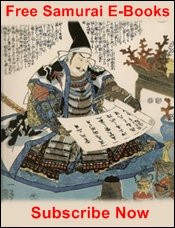
Get Free Exclusive Samurai Guides and E-books
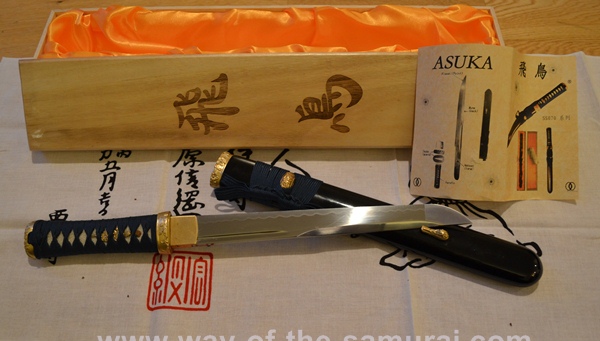
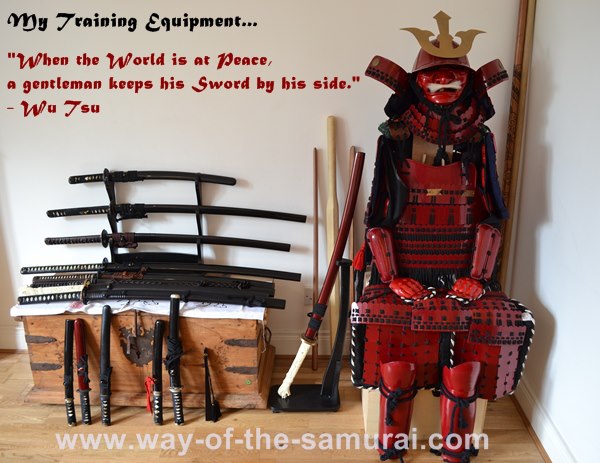
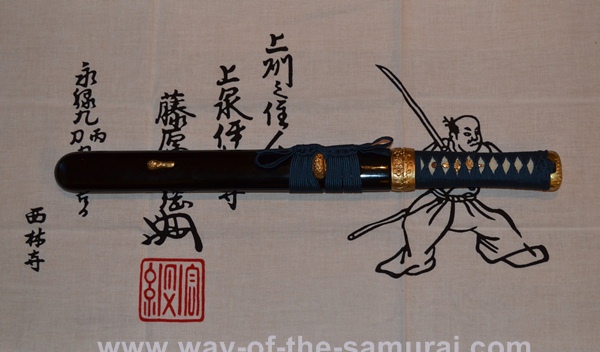
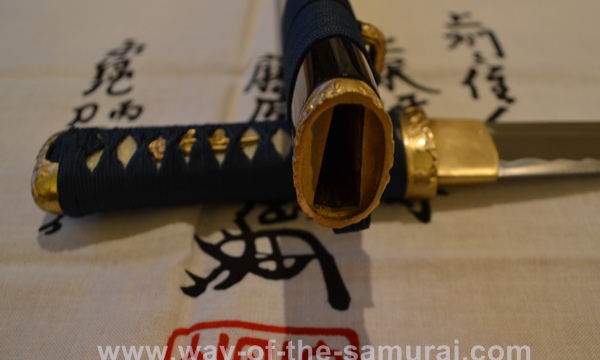
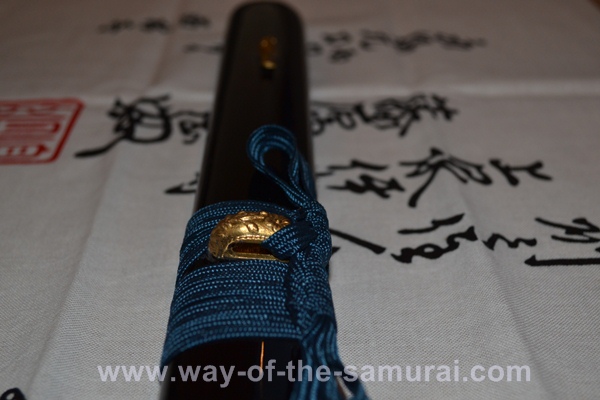
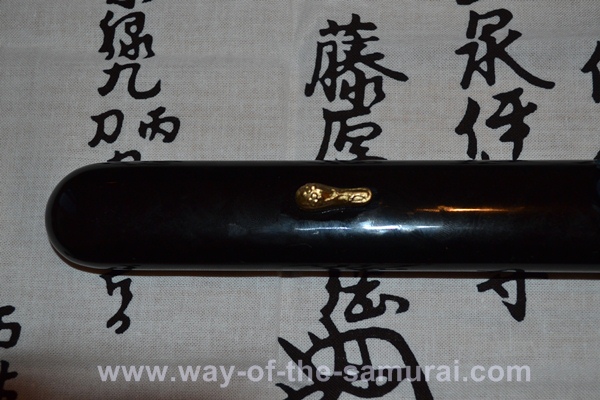
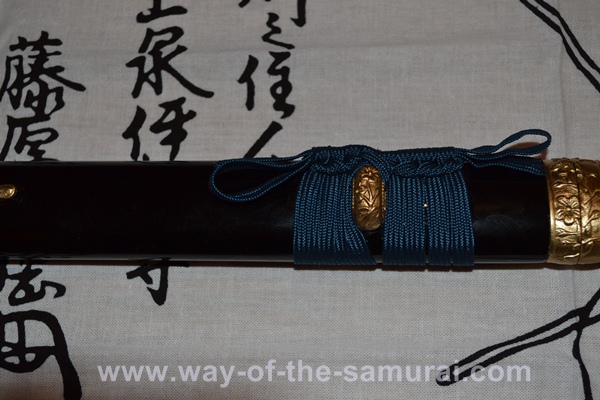
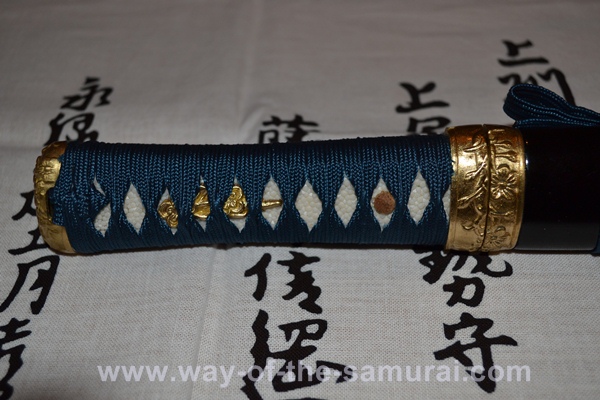
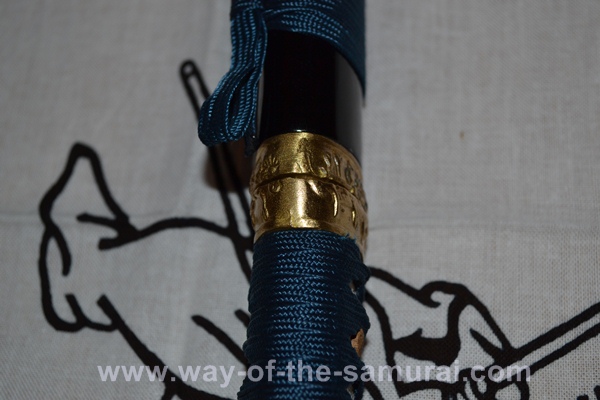
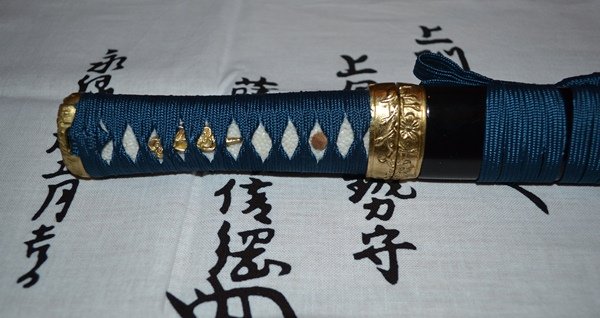
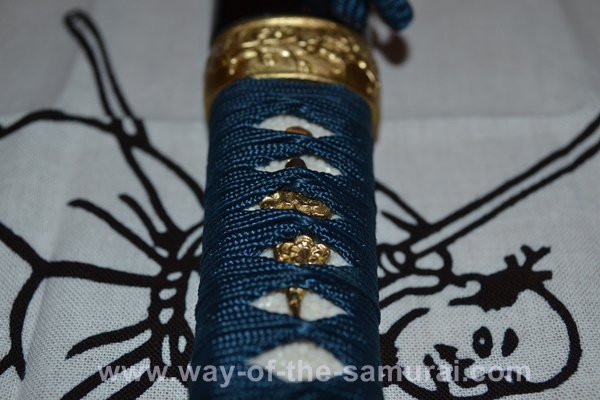
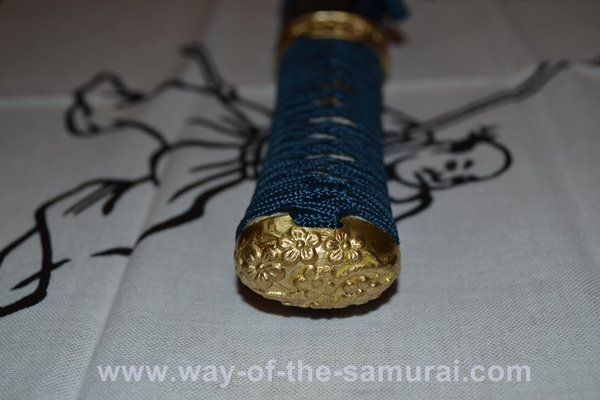
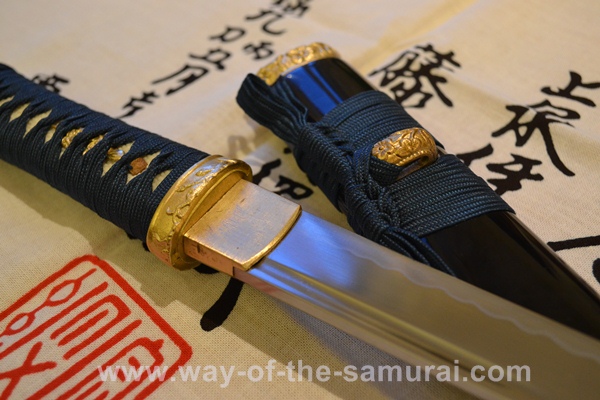
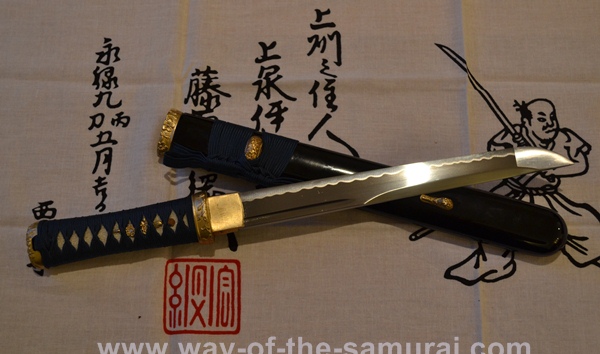
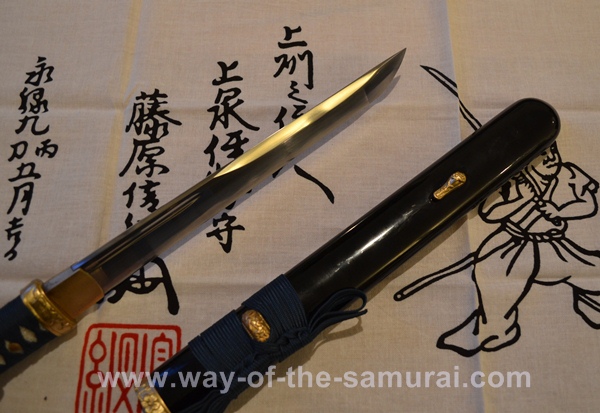
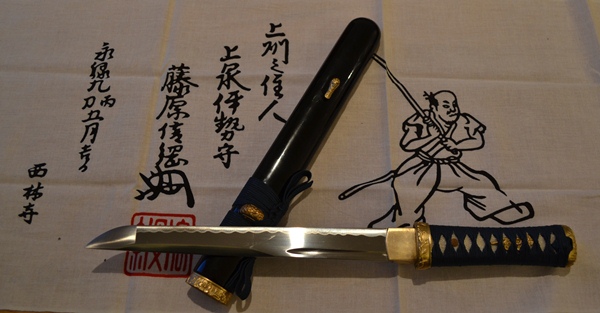
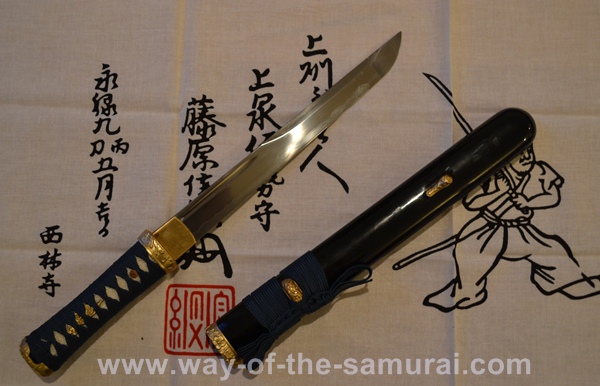





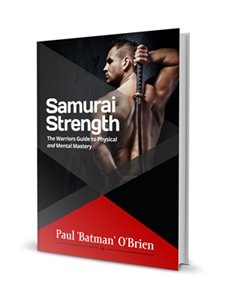
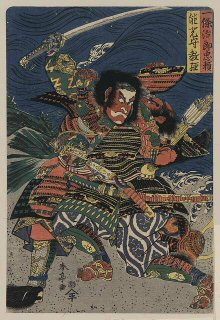
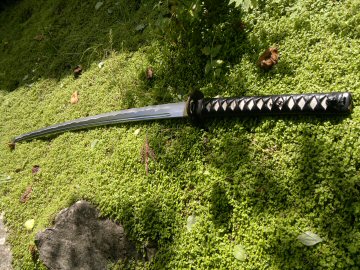
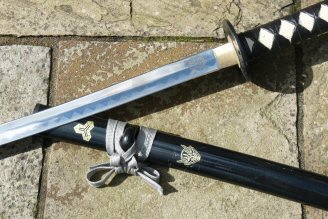
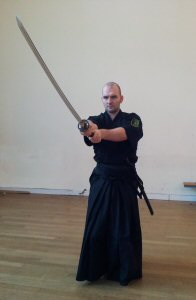
New! Comments
Have your say about what you just read! Leave me a comment in the box below.